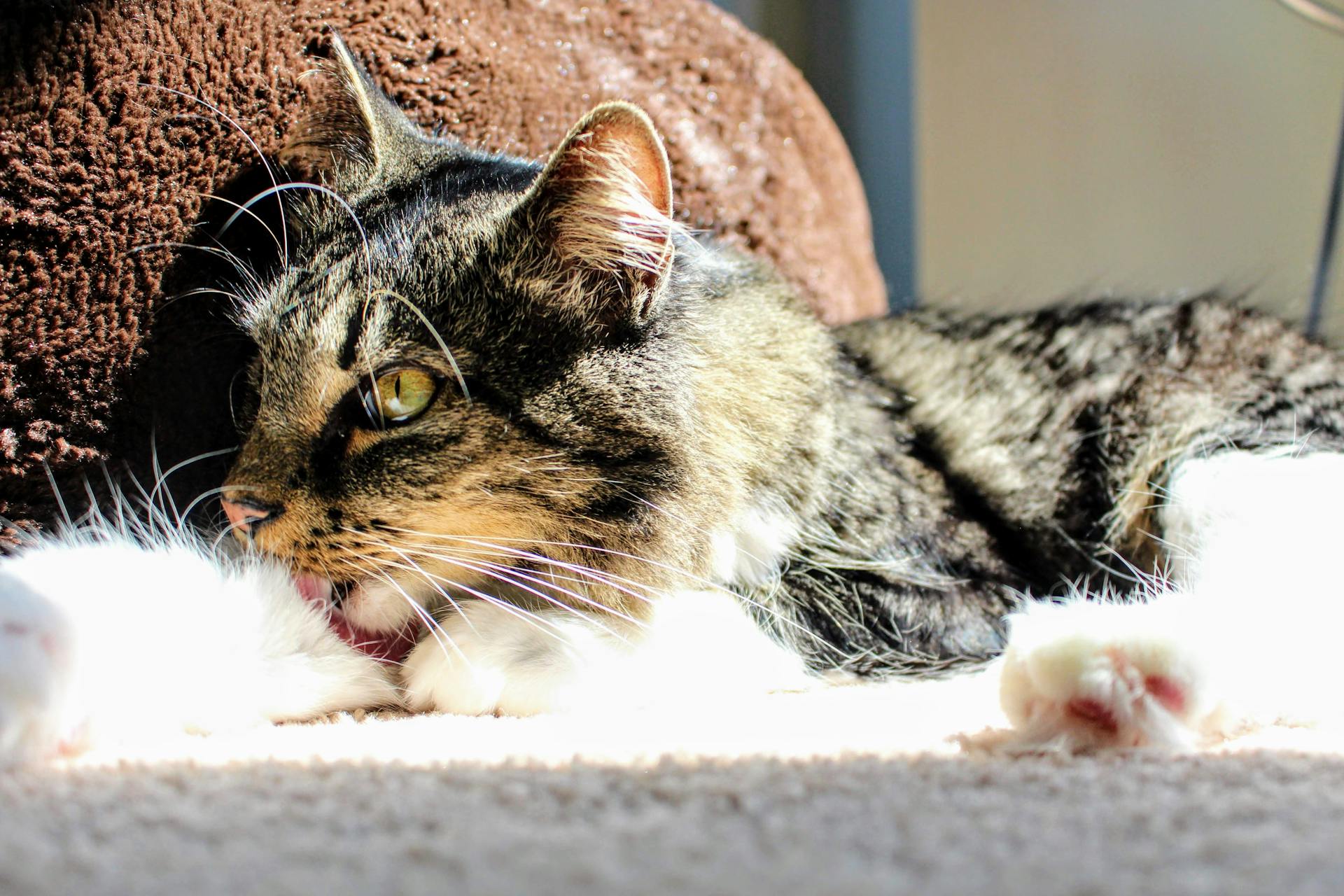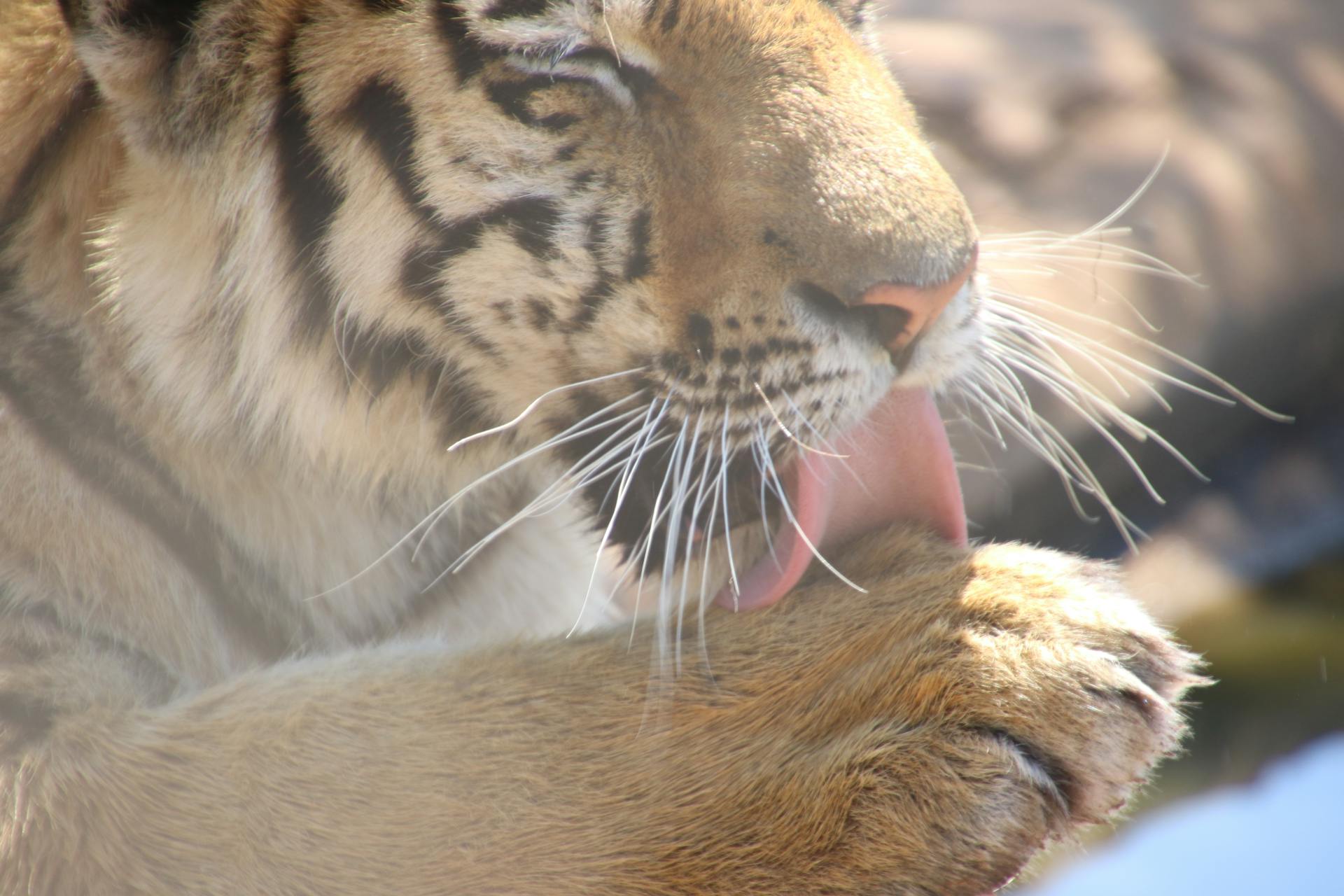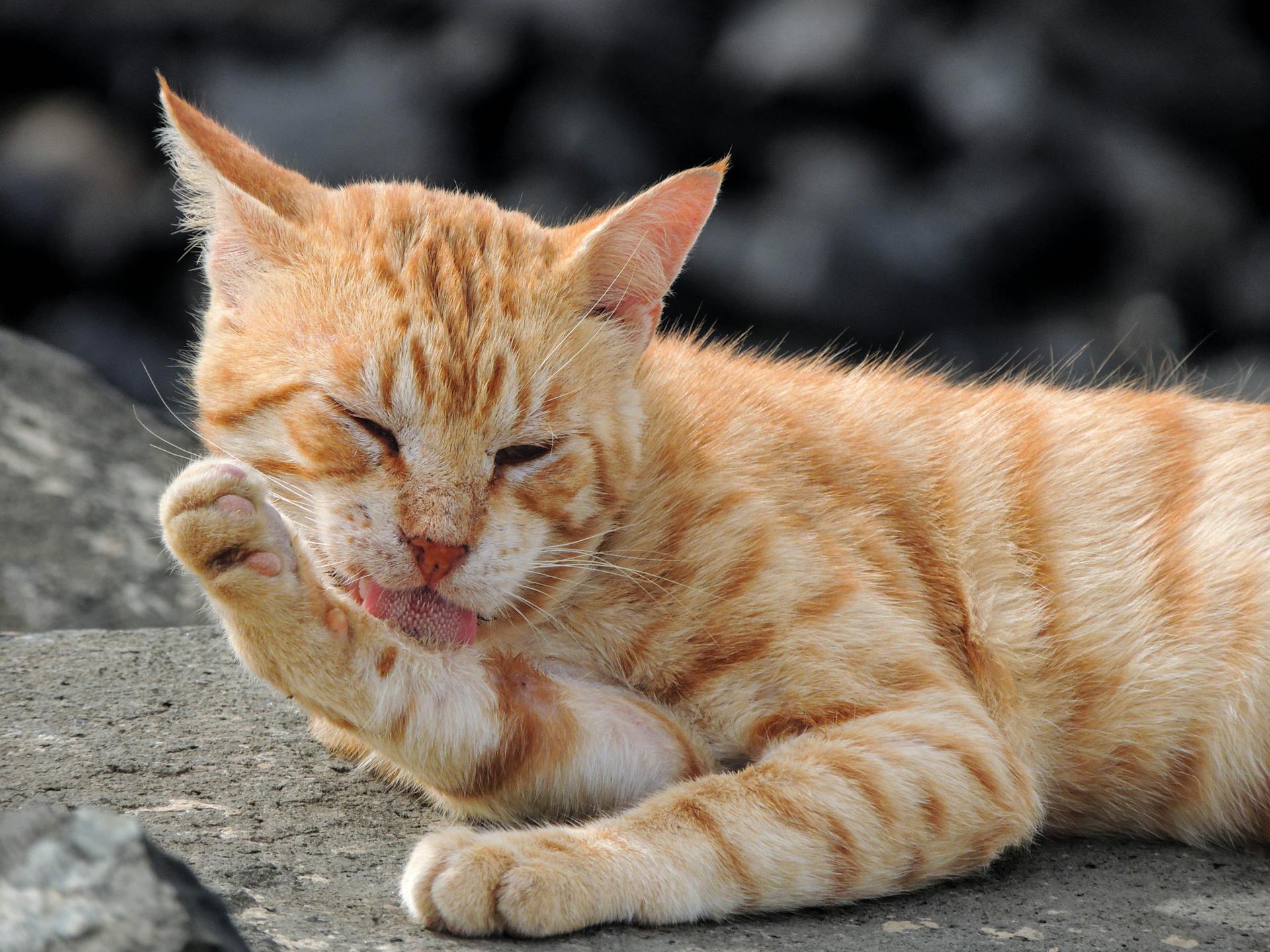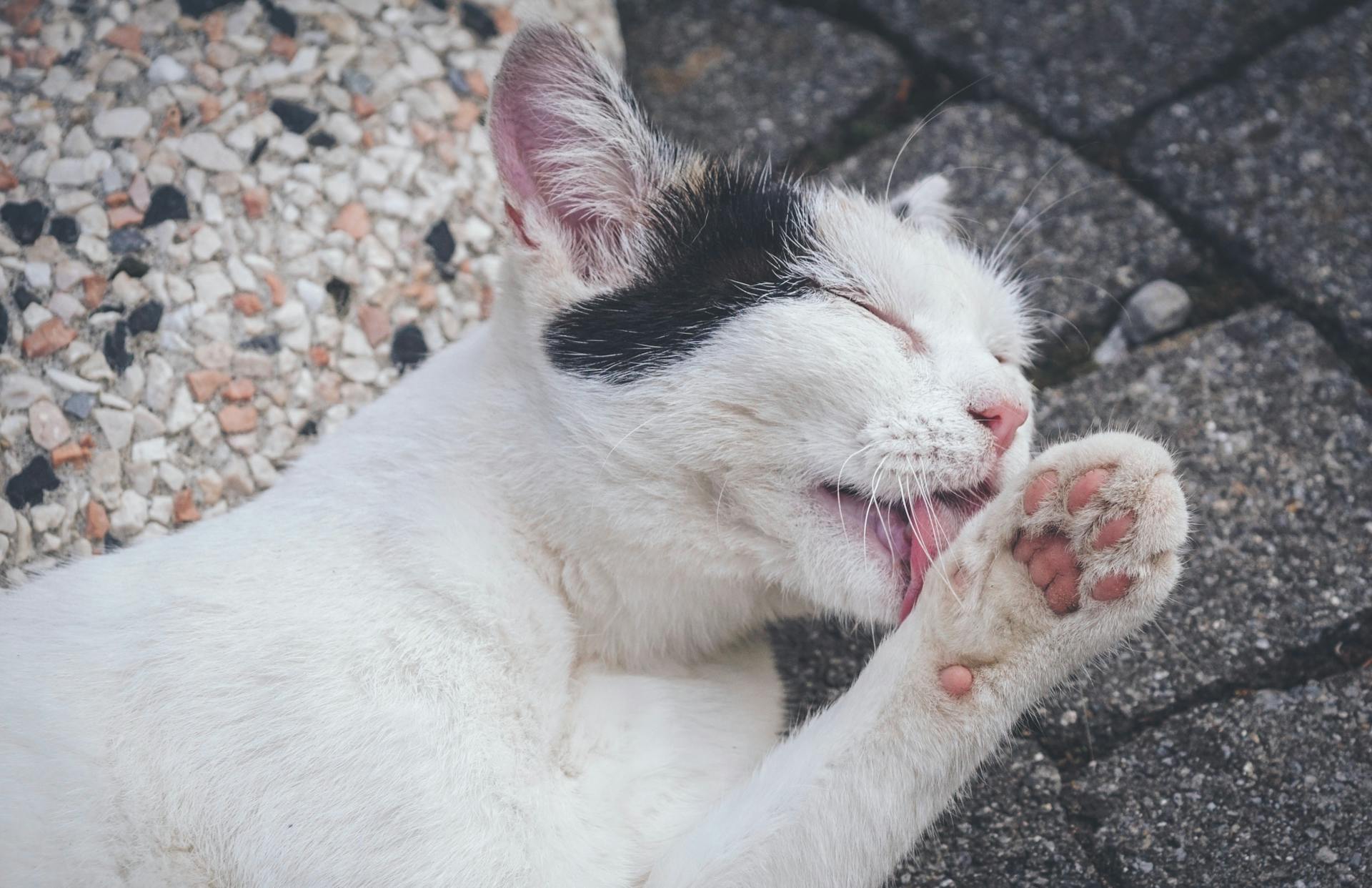
Lick granuloma in dogs is a frustrating and painful condition that can be challenging to diagnose and treat. It's a type of skin irritation that occurs when a dog excessively licks a specific area, leading to inflammation and scarring.
Dogs with lick granuloma often exhibit compulsive behavior, such as obsessive licking or chewing, which can be triggered by various factors including allergies, anxiety, or skin irritation. This behavior can be exhausting for both the dog and its owner.
The affected area may appear red, swollen, and inflamed, with a raised, thickened skin texture that can be painful to the touch. In some cases, the skin may crack and bleed, leading to secondary infections.
Treatment for lick granuloma typically involves addressing the underlying cause of the behavior, such as managing allergies or providing anxiety relief, in addition to topical treatments to promote healing and reduce inflammation.
If this caught your attention, see: Lick Granuloma vs Hotspot
What is Lick Granuloma?
Lick granuloma is a skin condition that appears as painful lesions on a dog's outer extremities, caused by chronic, compulsive licking of a concentrated area.
It's a self-perpetuating skin condition, which means the more your dog licks the area, the more it becomes inflamed, itchy, and painful.
The constant licking can damage the superficial skin layers, leading to immense discomfort for your dog.
This skin condition is also known as acral lick dermatitis, which is a clear indication of the area's location.
Lick granuloma is characterized by discrete excoriation, hair loss, thickened skin, and inflammation of the skin.
The area becomes raised, red, and itchy, which is why your dog will try to self-soothe with excessive licking, creating a vicious cycle.
The initial itch could have come from any given source, but the constant licking only aggravates the area more.
The more your dog licks the area, the more skin is damaged, and the more painful it becomes, perpetuating the cycle of itching and licking.
If this caught your attention, see: Toxocara Canis Life Cycle
Causes & Transmission
Lick granulomas are a complex condition with various causes, and understanding these factors is crucial for effective treatment. One common cause is psychological, related to stress, anxiety, separation anxiety, boredom, or compulsiveness, especially in large active dogs left alone for long periods of time.
Physical causes include bacterial or fungal infections, ectoparasites, metabolic disease, neoplastic disease, trauma causing nerve damage, allergies, or joint disease. Arthritic and mobility problems in older dogs give them more time to lick and over-groom themselves.
Hot spots may also lead to the formation of lick granulomas, creating a vicious cycle of pain and itching that perpetuates the condition. This cycle is exacerbated by the release of endorphins, powerful analgesics that can make the dog more inclined to continue licking.
The causes of lick granuloma can be broadly categorized into physical and psychological origins. Here are some of the main culprits:
- Physical causes: bacterial or fungal infections, ectoparasites, metabolic disease, neoplastic disease, trauma causing nerve damage, allergies, or joint disease
- Psychological causes: stress, anxiety, separation anxiety, boredom, compulsiveness, trauma
In some breeds, notably Doberman Pinschers and Great Danes, the cause of lick granuloma may not be found, making diagnosis more challenging.
Symptoms and Signs
Lick granulomas are often characterized by excessive licking of the skin in one area, which can be a sign of this condition.
Seventy percent of the time, lick granulomas occur on a dog's left leg.
The most common areas affected by lick granulomas are the lower portions of the legs, such as the carpus (wrist), or the base of the tail.
These lesions can initially be red, shiny, swollen, hairless, irritated, and bleeding, similar to a hot spot (wet eczema).
Eventually, a raised hard plaque forms.
Lick granulomas can become infected with bacteria, causing abscessed areas or fistulous tracts (furuncles).
The top of the wrist, around the ankle, and in between or on top of the toes are the most often affected regions of the body.
Other signs and symptoms include itchiness, hair loss, redden nodules, and as a result of being licked so often, the skin has eroded or ulcerated.
Lameness could occur due to infected skin or even arthritis.
If the skin infection is serious enough there might be a lack of appetite (anorexia) or lethargy.
Some dogs may have more than one lick granuloma at a time.
Identifying and Diagnosing
Identifying and Diagnosing Lick Granuloma can be a bit tricky, but knowing where to look is key. Lick granuloma often occurs on body parts that are easy to reach from a seated position, such as the top and outer surfaces of the front legs, especially the carpal joint and wrist.
The hind limbs and tail base are also common areas. Some dogs may even have several lick granulomas at the same time. If your dog is a contortionist, it's not uncommon for lick granuloma to occur in other areas as well.
A physical examination by a veterinarian can help identify the source of the lesions. To help the vet, it's a good idea to keep a record of the following:
- How long the excessive licking has occurred
- Any notable changes in your dog's routine or environment
- How frequently and in what situations your dog licks its wounds
- Any other medical history, like previous pain, surgeries, or trauma
When examining the affected area, look for symptoms such as alopecia (hair loss), erythema (skin redness), erosion or ulceration, inflammation, moistness or scabbing, focal infection, and hyperpigmentation.
Here are some common symptoms to watch out for:
- Alopecia (hair loss) in the form of nodules or plaques
- Erythema (skin redness)
- Erosion or ulceration
- Inflammation
- Moistness or scabbing
- Focal infection
- Hyperpigmentation
Treatment and Options
Treatment of lick granuloma requires addressing the suspected cause of the lesions. Bacterial infections, for example, are treated with antibiotics for weeks to months.
To stop the itch-lick cycle, your veterinarian may recommend a combination of treatments, including antibiotics, anti-inflammatories, and anti-irritant hot spot hydrogel.
Some alternative therapies that may be helpful in treating lick granuloma include cold laser treatment, acupuncture, and homoeopathy. A homoeopath will look at your dog's entire health as well as the physical issues and select a treatment and following remedies to treat the lick granuloma.
Topical ointments, such as those containing antibiotics, steroids, and pain relievers, can be applied directly to the lick granuloma to promote healing and soothe the skin.
Here are some common antibiotics used to treat lick granuloma:
- Cephalexin
- Primor
- Baytril
- Clavamox
Treatment
Treatment options for lick granuloma vary depending on the underlying cause. You can target the source with oral and topical solutions or medical procedures like antibiotics, topical antimicrobial spray, anti-inflammatories, anti-irritant hot spot hydrogel, and surgery.

For physical causes, your veterinarian may recommend antibiotics, topical antimicrobial spray, or anti-inflammatories. In some cases, surgery may be necessary to remove the lesion.
To prevent your dog from licking the area, you can use a mechanical blocking device such as a collar, muzzle, or bandage.
Oral antidepressant medications may be helpful in treating the obsessive-compulsive component of lick granuloma.
A topical product may be used to decrease the itchiness of the area and aid in the healing process.
Here are some alternative therapies that may be helpful in treating lick granuloma:
- Cold laser treatment
- The Assisi loop (a pulsed electromagnetic frequency device)
- Acupuncture
- Chiropractic care to examine for misalignments and concealed pain
- Homeopathic treatment with a homoeopathic veterinarian or practitioner
- Using oils such as olive oil to reduce inflammation and soothe the skin
Topical ointments, such as lotion, cream, or ointment, can be administered directly to the lick granuloma. These medicines are usually a mix of antibiotics, steroids, anti-inflammatories, capsaicin, and pain relievers.
Antibiotics are the most important treatment for lick granuloma, and may need to be used for 4-6 months due to the chronic nature of the problem. In some cases, pulse therapy may be necessary.
Consider reading: Dog Lick Granuloma Treatment

If your dog's lick granuloma is not caused by lick granuloma, it could be a symptom of another condition such as neoplastic disease, dermatophyte infection, orthopedic causes, demodicosis, or tumors. Your veterinarian may perform further tests on the lesions to determine the true cause.
Here are some conditions that your veterinarian will test for:
- Neoplastic disease
- Dermatophyte infection
- Orthopedic causes like arthritis
- Demodicosis (red mange)
- Tumors
Your veterinarian may also recommend the following treatments:
- Joint pain management
- Infection treatment
- Allergy treatment
- Minor irritant treatment (bug bites, scratches, etc.)
Food Allergy Diet
A food allergy diet can be a game-changer for pets with skin conditions caused by allergies. We recommend feeding hypoallergenic diets to these pets.
Feeding a hypoallergenic diet is a crucial part of managing a pet's allergy symptoms.
Expand your knowledge: Canine Pancreatitis Diet Recipes
Prevention and Prognosis
Dogs that receive early treatment for lick granuloma have a better prospect of recovery than dogs with chronic conditions.
Preventing lick granulomas is easier than treating them, so it's essential to catch any potential issues early on. If you notice your dog licking a particular area more than usual, consult your veterinarian as soon as possible.
Annual check-ups with your veterinarian can help identify any underlying causes of lick granuloma and treat them before they become serious problems.
Prevention

Regular check-ups with your veterinarian can help prevent lick granulomas by identifying and treating underlying causes before they become serious issues.
Annual check-ups are recommended to ensure your dog's health and well-being.
Increasing your dog's activity level can also help prevent lick granulomas, especially for large breed dogs that require a lot of exercise to release pent-up energy.
Exercise can be as simple as longer walks or more time spent chasing a ball.
Adding engaging toys to your dog's environment can keep its mind and body engaged, reducing the likelihood of anxiety-related behaviors like persistent licking.
A happy dog is often a weary dog, so make sure to provide plenty of physical and mental stimulation.
Providing a well-balanced, whole-food diet is also essential for preventing lick granulomas, and options like raw food or gently cooked dog food are available.
A regular daily schedule and quality time with you can also help prevent lick granulomas by reducing feelings of loneliness and boredom.
Related reading: Can Dogs Become Allergic to Their Food
Complications & Prognosis
When dealing with acral lick granuloma, it's essential to understand the potential complications and prognosis.
Dogs with acral lick granuloma can experience chronic conditions, which make treatment more challenging.
Early treatment is crucial for a better prospect of recovery, as it can improve the dog's chances of healing.
Veterinarians usually give a guarded prognosis to dogs with acral lick granuloma, indicating a cautious outlook on recovery.
Dogs receiving early treatment have a better prospect of recovery than those with chronic conditions.
Readers also liked: Acral Lick Dermatitis in Dogs
Frequently Asked Questions
Do lick granulomas hurt dogs?
Yes, lick granulomas can cause pain and discomfort for dogs, making it essential to understand their causes and symptoms to provide proper care. If left untreated, lick granulomas can also lead to infection, making prompt attention crucial.
Does hair grow back after lick granuloma?
Hair growth may be permanently affected in areas with frequent lick granulomas, potentially leading to permanent hair loss. In some cases, hair may not grow back at all.
Is lick granuloma a tumor?
No, a lick granuloma is not a skin tumor. It's a benign skin lesion caused by excessive licking, often due to allergies or anxiety.
Will a lick granuloma go away on its own?
A lick granuloma typically won't heal on its own without treatment, as the underlying conditions causing it need to be addressed. Treatment is necessary to confirm the diagnosis and promote healing.
How do you treat a lick granuloma in a cat?
Treatment for lick granuloma in cats typically involves protecting the damaged skin with bandages or collars, and may also include medications such as antibiotics, antifungal drugs, or antihistamines. Your veterinarian will recommend the best course of treatment for your cat's specific condition.
Featured Images: pexels.com

